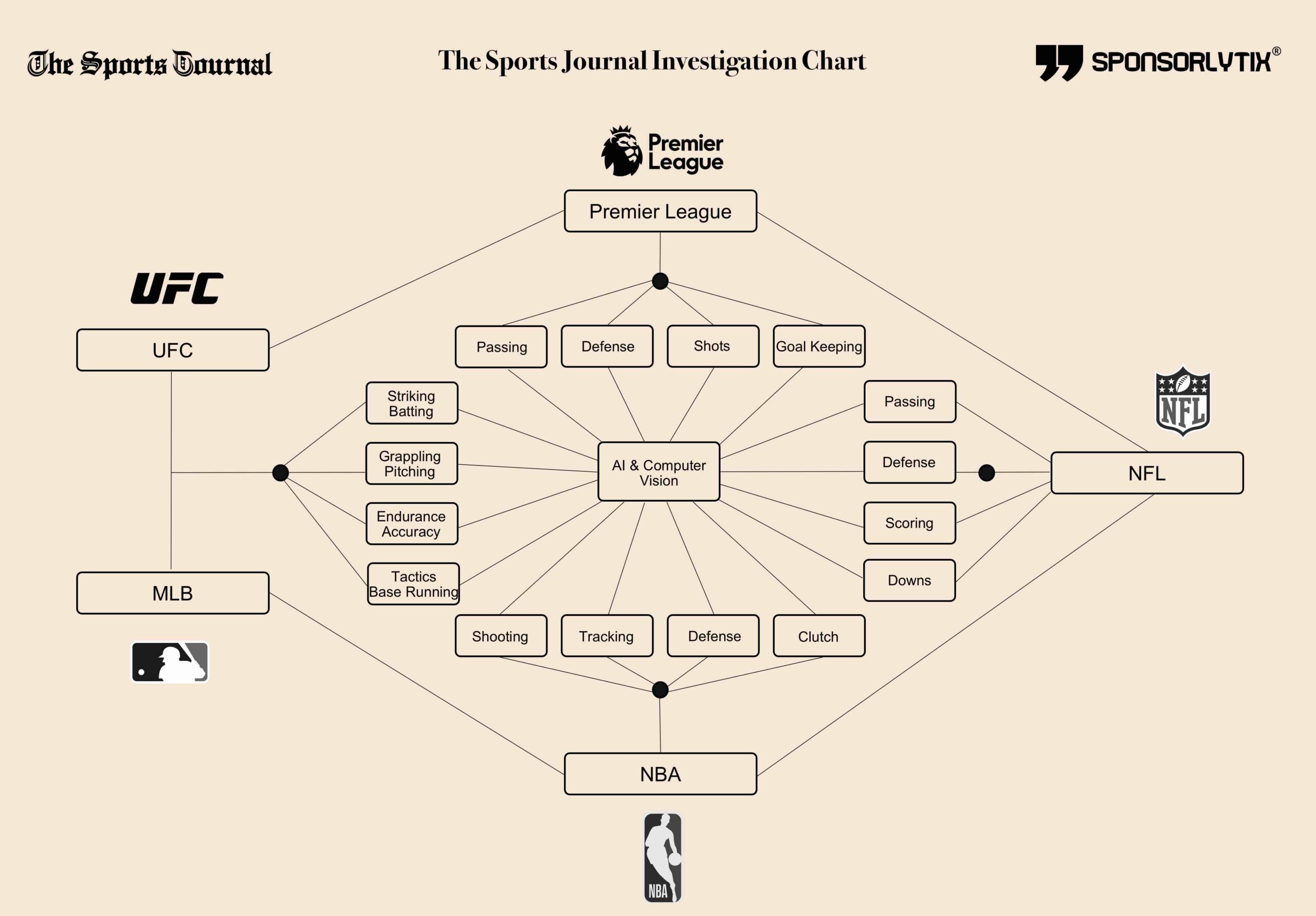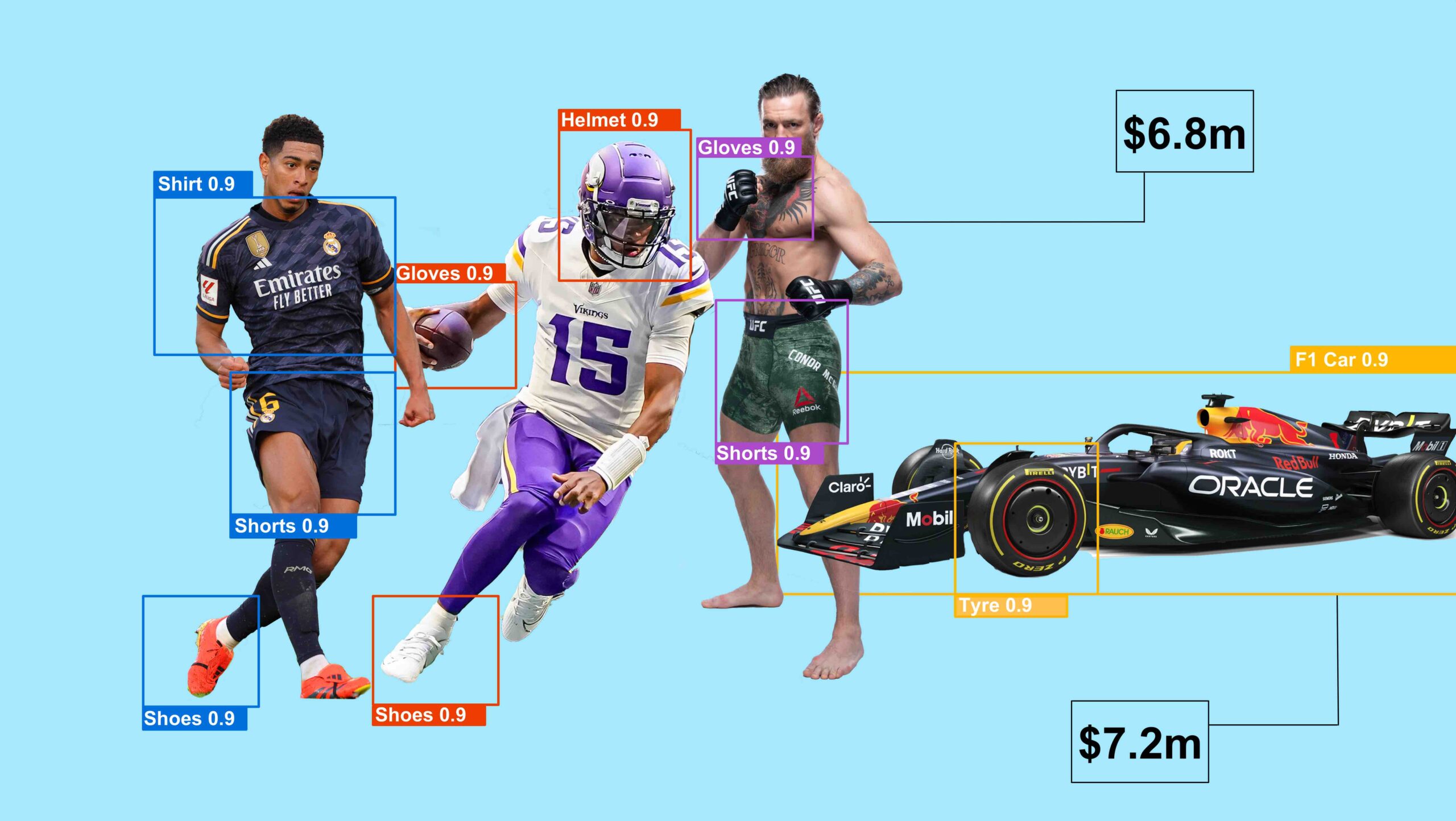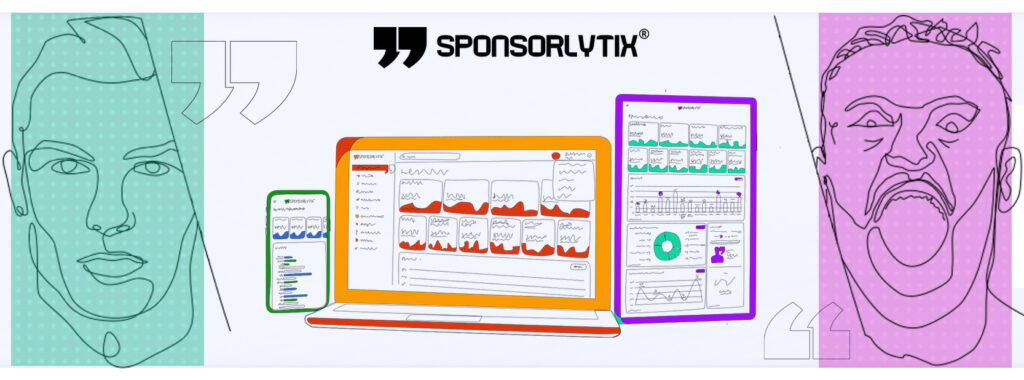|
Listen to this Article (Audio)
|
You must have heard the phrase “data is the new oil”, in the ever-evolving world of sports, more and more data has been integrated into every facet of the game. Technology continues to play a pivotal role in reshaping the way athletes train, compete, clubs and governing bodies expand their presence to generate more revenues, and fans engage with their favourite clubs.
One of the most revolutionary advancements in recent years is the integration of computer vision and artificial intelligence (AI) into the sports industry. Over the past half-decade, the synergy between AI and Computer Vision technologies has propelled forward the world of sports, making the game faster and better, however some argue, making athletes more “robotic” rather than “creative”.
So how has sports changed over the past half-decade? The Sports Journal alongside sports AI company, Sponsorlytix, conducted a comprehensive analysis by compiling extensive data on four key metrics for each of the five different sports. With the aims to explore the multifaceted impact of computer vision and AI technology on various aspects of sports, ranging from performance analysis and injury prevention to fan engagement and officiating.
The process involved aggregating the performance statistics of every individual team, spanning the years from 2019 to 2023. The four metrics, carefully chosen to encapsulate various aspects of team performance, were thoroughly examined.

Read our investigation – Illegal Sports Streaming & Piracy
Delving into the transformative impact of these cutting-edge technologies on five prominent sports leagues—Football (Premier League), American Football (NFL), MMA (UFC), Basketball (NBA), and Baseball (MLB). We explore how AI and Computer Vision have not only reshaped the way these sports are played but have also revolutionized the analysis and enhancement of athlete performance. In some instances, the trend has gone worse.
Performance Metrics and Parameters:
Football (Premier League) ![]()
| Year | Passing Accuracy | Defensive Positioning | Take-On Shots | Goalkeeping Saves |
| 2019 | 57.68% | 43.73% | 42.4% | 68.78% |
| 2020 | 57.35% | 40.13% | 45.1% | 67.78% |
| 2021 | 57.43% | 40.81% | 38.85% | 70.16% |
| 2022 | 58.87% | 44.67% | 43.5% | 69.62% |
| 2023 | 59.29% | 47.91% | 37.85% | 68.49% |
Source: Sponsorlytix, Premier League, NFL, UFC, NBA, MLB
American Football (NFL) ![]()
| Year | Passing Accuracy | Defensive Interceptions | Scoring | Downs |
| 2019 | 62.1% | 12.19% | 38.50% | 22.77% |
| 2020 | 65.27% | 12.38% | 44.69% | 27.58% |
| 2021 | 64.83% | 12.53% | 44.81% | 25.16% |
| 2022 | 63.71% | 14.34% | 38.91% | 24.5% |
| 2023 | 64.89% | 13.31% | 39.97% | 23% |
Source: Sponsorlytix, Premier League, NFL, UFC, NBA, MLB
MMA (UFC) ![]()
| Year | Striking Accuracy | Grappling Effectiveness | Endurance & Control | Tactical Decision Making |
| 2019 | 60.3% | 68.3% | 79.4% | 69% |
| 2020 | 60.5% | 68.3% | 80% | 69.27% |
| 2021 | 61.89% | 69.2% | 81.9% | 70.66% |
| 2022 | 61.35% | 71.68% | 86.5% | 73.18% |
| 2023 | 63.2% | 72.42% | 85.7% | 73.44% |
Source: Sponsorlytix, Premier League, NFL, UFC, NBA, MLB
Basketball (NBA) ![]()
| Year | Shooting Accuracy | Tracking EFG | Defensive Capabilities | Clutch |
| 2019 | 57.3% | 48.3% | 40.33% | 38.9% |
| 2020 | 58.9% | 50.9% | 42.9% | 39.98% |
| 2021 | 59.8% | 52.1% | 43.7% | 41.45% |
| 2022 | 61.3% | 53.53% | 45.72% | 42.35% |
| 2023 | 62.24% | 55.71% | 47.79% | 42.69% |
Source: Sponsorlytix, Premier League, NFL, UFC, NBA, MLB
Baseball (MLB) ![]()
| Year | Batting Accuracy | Pitching Speed | Pitching Accuracy | Base Running Speed |
| 2019 | 58.55% | 53.9% | 60.98% | 38.9% |
| 2020 | 58.77 | 54.2% | 61.2% | 39.98% |
| 2021 | 60.69% | 54.33% | 61.75% | 41.45% |
| 2022 | 62.82% | 57.8% | 63.8% | 42.35% |
| 2023 | 63.2% | 55.13% | 64.4% | 42.69% |
Source: Sponsorlytix, Premier League, NFL, UFC, NBA, MLB
Different sports leagues and clubs have embraced technologies like GPS trackers, which track player movements, providing invaluable insights into sprint speed, defensive positioning, and base running speed. Complementing this, computer vision technology captures precise ball trajectories, several athlete and tactical data enabling in-depth analysis of shooting accuracy, passing precision, and fielding efficiency.
Moreover, the integration of computer vision technology has revolutionized real-time player tracking and event recognition. Leveraging sophisticated object detection algorithms, AI is deployed for biomechanical analyses, correlating player techniques with successful outcomes across various plays, refining team strategies and game plans.
Technologies such as heart rate tracking and fatigue level analysis provide insights into player readiness and performance capacity, contributing to a comprehensive view of player dynamics. Performance benchmarking, facilitated by establishing baseline metrics for players, allows for regular comparisons to assess improvements over time, driving continuous enhancement in player performance.
In essence, the integration of these diverse technologies underscores a commitment to unraveling the intricacies of sports performance. By delving deep into player dynamics, strategies, and overall performance, these technological advancements redefine the landscape of sports analysis and elevate the standard of athletic excellence.
Source: Sponsorlytix, Premier League, NFL, UFC, NBA, MLB
Integration of AI & Computer Vision in Sports:
The use of computer vision and AI in sports has ushered in a new era of performance analysis. Player tracking systems, equipped with cameras strategically placed around the playing field, capture every movement of athletes. These systems generate vast amounts of data, including player positioning, speed, and acceleration. Organizations like the NBA have embraced this technology to gain valuable insights into player performance.
Player tracking systems have led to a 8 to 15% increase in team efficiency in the NBA year-on-year. Coaches can now analyze player movements, identify patterns, and make data-driven decisions to optimize team strategies.
Football leads the way with a 37.6% share when it comes to integrating AI & computer vision into the sport as a whole, highlighting the sport’s extensive reliance on these advanced technologies for purposes ranging from performance analysis to injury prevention. Tennis follows closely at 24.7%, a sport that has been one of the first to embrace data and use assisted refereeing with Hawkeye technology.
Basketball has recently expanded widely and adopted the use of AI into its tactical strategies, with a 9.4% share, indicating a substantial but comparatively lower incorporation of AI and computer vision in enhancing gameplay and athlete performance
Golf (8.2%), American Football (4.7%), Motorsport (4.7%), and others collectively underscore the industry-wide acknowledgment of the transformative potential of AI and computer vision in optimizing training methodologies and refining game strategies.
The distribution of percentages across various sports signifies a comprehensive embrace of technology to enhance athlete performance and overall sports experiences. The notable presence of these technologies in sports like Golf, Athletics, and Motorsport demonstrates the versatility of AI and computer vision applications, ranging from swing analysis in Golf to performance tracking in Athletics and advanced analytics in Motorsport. As these percentages continue to evolve, it is evident that the sports industry is increasingly relying on cutting-edge technologies to push the boundaries of performance, strategy, and the overall fan experience
Source: Sponsorlytix, Premier League, NFL, UFC, NBA, MLB
Injury Prevention and Rehabilitation
AI algorithms are being employed to analyze biomechanical data, aiding in injury prevention and rehabilitation. For instance, wearables embedded with sensors can track an athlete’s movement patterns and provide real-time feedback to minimize the risk of injuries. The implementation of computer vision in physical therapy is also gaining traction, as it allows for precise tracking of an athlete’s rehabilitation progress.
A study published in the Journal of Sports Science & Medicine demonstrated that athletes using AI-assisted rehabilitation programs experienced a 20% faster recovery rate compared to traditional methods. The ability to tailor rehabilitation programs based on individual performance data contributes significantly to reducing downtime for athletes.
Read our investigation – Overpaid Football Players Salaries
Analyzing the data on injury patterns in sports teams after implementing computer vision-based monitoring systems reveals interesting trends across various sports leagues. In the Premier League, the number of injuries has steadily increased from 495 in 2019 to 1884 in 2023. This rise may suggest that, despite the implementation of computer vision-based monitoring systems, injury rates have significantly increased, whether that is down to individual players not taking in the required recovery sessions after games and training sessions or the increase in the amount of games each season.
In contrast, the NFL experienced a substantial decrease in injuries from 990 in 2019 to 495 in 2023, indicating a potential positive impact of AI and computer vision technologies in curbing injuries in American football. The amount of games each NFL team plays has been the same more or less over the past half decade.
In the NBA, there was a slight decline in injuries from 351 in 2019 to 334 in 2023, however, the MLB saw a slight increase in injuries from 179 in 2019 to 214 in 2023.
The UFC exhibited a fluctuating pattern, with a decrease in injuries from 291 in 2019 to 171 in 2022, followed by a slight increase to 193 in 2023. Overall, the data suggests that the effectiveness of AI and computer vision technologies in mitigating injuries varies across sports, with notable improvements in the NFL and NBA but less consistent results in the Premier League, MLB, and UFC.
Source: Sponsorlytix, Premier League, NFL, UFC, NBA, MLB
AI-Driven Gameplay And Tactical Analytics
Machine learning algorithms can uncover patterns in player strategies, map dynamics, and team co-ordination. By understanding these patterns, teams can adapt their tactics, identify opponents’ weaknesses, and stay ahead of competition.
AI-driven gameplay analytics also contribute to the development of personalized training programs, as the technology can identify individual player strengths and areas for improvement based on their in-game performance data.
Computer vision technology is revolutionizing player performance analysis in esports by capturing and analyzing intricate details of player biometrics. Additionally, gesture recognition using computer vision allows for the analysis of players’ physical movements and reactions. This information is invaluable for improving player ergonomics, optimizing training regimens, and enhancing overall gameplay performance.
The progression in the percentage of insights gained from computer vision analysis during games over the years reveals a growing reliance on this technology for extracting valuable information in sports. In 2019, the utilization stood at 38%, signifying a relatively modest adoption of computer vision for game analysis. However, as evidenced by the subsequent years, there has been a substantial increase in its application. By 2023, the percentage has surged to 71%.
Read our investigation – Gaming Wars For Dominance
Source: Sponsorlytix, Premier League, NFL, UFC, NBA, MLB
AI & Computer Vision Usage in TV Broadcast
The integration of AI and computer vision into TV broadcasts has witnessed steady growth across various sports leagues in recent years. In the Premier League, the utilization of these advanced tools surged from 13% in 2019 to an impressive 35% by 2023, reflecting a concerted effort to enhance the viewing experience through data-driven insights and enhanced visuals.
Similarly, the NFL demonstrated a substantial increase from 17% in 2019 to 33% in 2023, underscoring a significant adoption of AI and computer vision to augment the coverage of America’s most popular sport. This rise reflects a broader trend in sports broadcasting, where leagues are leveraging technology to provide viewers with more engaging and informative content, enriching their connection to the game.
Furthermore, the trajectory of AI and computer vision usage in TV broadcasts extends beyond traditional sports like football and basketball, extending into combat sports such as UFC. Over the years, the UFC has embraced these technologies, with a notable rise from 8% in 2019 to 24% in 2023.
This trend highlights a growing recognition of the value these tools bring in delivering immersive and insightful coverage, capturing the nuances of each match and enhancing the overall viewing experience for fans. Similarly, in the MLB and NBA, AI and computer vision usage has seen steady growth, indicating a broader industry shift towards data-driven storytelling and enhanced visualizations to captivate audiences and elevate the sports broadcasting landscape.
By harnessing AI and computer vision, broadcasters can offer enhanced visualizations, such as detailed player statistics, real-time data analysis, and augmented reality graphics, enriching viewers’ understanding of the game and fostering deeper engagement. Moreover, it enables broadcasters to facilitate more insightful discussions during halftime analyses and post-match breakdowns. Pundits can leverage advanced analytics and visual aids to dissect team strategies, player performances, and key moments in the game, providing audiences with deeper insights and enriching the overall narrative.
Source: Sponsorlytix, Premier League, NFL, UFC, NBA, MLB
Increase In Goal Scoring Trends In The Premier League
The increase in goal-scoring trends in the Premier League shows very minimal fluctuations in scoring patterns. In 2019, the league recorded a total of 1072 goals, with a slight decline in goal numbers in the subsequent years. 1034 goals in 2020 and 1024 goals in 2021. The trend reverses in 2022 and 2023, with the goal-scoring figures rising to 1071 and 1084, respectively.
The consecutive increase in goal-scoring from 2022 to 2023 might indicate a shift back towards a more attacking style of play, individual player development within different teams or potentially influenced by tactical adaptations. Overall, the fluctuating numbers underscore the dynamic nature of football and the Premier League, where goal-scoring trends can be influenced by various elements that impact the sport on both macro and micro levels.
Source: Sponsorlytix, Premier League, NFL, UFC, NBA, MLB
Video Assistant Referee (VAR) in Football
One of the most visible impacts of computer vision in sports is its role in officiating. In football, the introduction of Video Assistant Referee (VAR) technology has sparked widespread debate and discussion. VAR utilizes multiple camera angles and AI algorithms to assist referees in making critical decisions, such as offside calls and fouls.
A report by the International Football Association Board (IFAB) revealed that VAR implementation has increased the accuracy of refereeing decisions by 98%. While controversial at times, VAR has played a crucial role in ensuring fairness and justice on the football field.
Computer Vision in Sponsorship Measurement
Sponsorship deals in sports involve substantial financial investments from brands seeking to connect with a specific audience through the influence of athletes and teams. The effectiveness of these partnerships must be measured accurately to justify the expenditure and to optimize future collaborations. Traditional methods of sponsorship measurement, such as brand exposure through broadcast time, lack the granularity needed to provide a comprehensive understanding of the impact.
Computer vision technology has emerged as a game-changer in sponsorship measurement by enabling precise visual recognition and logo tracking. Advanced algorithms can analyze vast amounts of visual content, such as broadcast footage, social media posts, and even fan-generated content, to identify and track sponsor logos in real time.
Premier League Football Clubs Sponsorship Revenue Data
This level of detail allows sponsors to gauge the actual visibility and exposure of their branding during games, events, and across various media platforms. Accurate logo tracking ensures that sponsors receive the visibility they paid for and provides valuable insights for optimizing sponsorship strategies.
The data on Sponsorship Revenue across various sports leagues reveals interesting trends in the financial impact of using AI and computer vision in sports. In the Premier League, there is a consistent increase in sponsorship revenue from $0.88 billion in 2019 to $1.18 billion in 2023.
Similarly, the NFL experiences a steady growth in sponsorship revenue, rising from $1.45 billion in 2019 to $2.05 billion in 2023. In the NBA, sponsorship revenue also demonstrates a positive trend, increasing from $1 billion in 2019 to $1.66 billion in 2023, indicating that the league’s adoption of advanced technologies has potentially contributed to its financial growth.
However, the UFC and MLB show relatively modest changes in sponsorship revenue over the years. While the UFC experiences a slight increase from $0.12 billion in 2019 to $0.2 billion in 2023, the MLB sees a more gradual rise from $1 billion in 2019 to $1.5 billion in 2023.
Source: Sponsorlytix, Premier League, NFL, UFC, NBA, MLB
Machine Learning for Predictive Analytics
Machine learning algorithms can analyze historical data to predict future fan engagement trends. By considering factors such as team performance, player popularity, and specific game dynamics, sponsors can anticipate the potential reach and impact of their branding within upcoming events.
Predictive analytics empower sponsors to make informed decisions on when and where to invest, maximizing the return on investment and ensuring their brand is associated with high-impact moments.
Over the past half-decade, these technologies have propelled the world of sports forward, enhancing performance analysis, injury prevention, and fan engagement. However, amidst these advancements, there are concerns about the potential for athletes to become more “robotic” and less “creative” in their approach to the game.
As evidenced by the increasing adoption rates across various sports leagues, including football, tennis, and basketball, it is clear that AI and computer vision are here to stay. The versatility of these technologies, from real-time player tracking to biomechanical analysis, underscores their transformative potential in optimizing training methodologies and refining game strategies.























